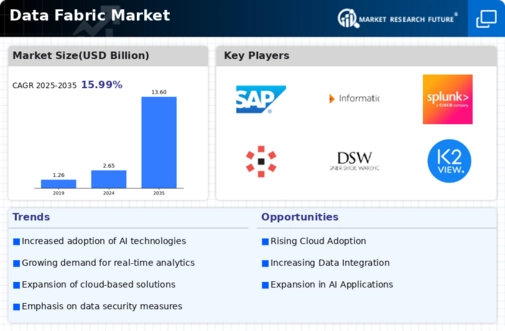Market Share
Data Fabric Market Share Analysis
The Data Fabric market has witnessed major trends due to the increased necessity by firms to control vast volumes of growing big data stocks. One trend worth mentioning here involves the rising number of users of data fabric technology in order to address the problems associated with access and interconnectivity among different environments. Data Fabric market trends are influenced by cloud adoption. There is an increasing demand for solutions that allow data to be moved across hybrid and multi-cloud environments as organizations migrate their storage, processing, and analytics to the cloud. These evolving tools also support seamless integration with cloud platforms, unlocking scalability and flexibility without sacrificing control over the enterprise's data sources. The rise of edge computing is influencing the capabilities of Data Fabric solutions. As computing resources are deployed closer to where data is being generated, efficient management and orchestration of data at the edge becomes necessary. Data Fabric Solutions have been adapted to support edge computing so as to enable organizations to integrate and analyze real-time data at the edge. The growing importance given to data governance and compliance can be seen within the Data Fabrication field. In order to meet GDPR requirements or enforce other kinds of laws on personal information protection, companies focus on robust governance capabilities provided by these Dataprivacycentric solutions that aid in mapping out policies related to data usage all through its lifecycle while ensuring quality throughout its integrity factors into it from a regulatory perspective as well. Artificial intelligence (AI) and machine learning (ML) are instrumental in shaping the competencies of Data Fabric. To understand the intricacies of modern data environments, a lot of smart automation is needed for data discovery, integration, and analysis. The need to expand access to data is driving development around Data Fabric solutions. Firms now allow non-technical users to access and make sense of data without involving extensive IT personnel. Data Fabric solutions aim to transform data into interactive user interfaces that are friendly to businesspeople. It is worth noting that security has become a very important decision factor about trends in Data Fabric market movements as well.









Leave a Comment